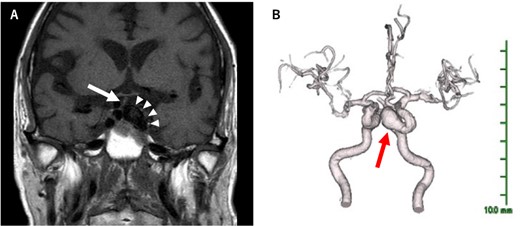-
PDF
- Split View
-
Views
-
Cite
Cite
Takahiro Ishikawa, Daiki Yamamoto, Tomonori Kato, Takahiro Mori, Toshio Machida, Masatsune Ogura, Hyponatremia due to hypopituitarism caused by cerebral aneurysm, Age and Ageing, Volume 51, Issue 12, December 2022, afac291, https://doi.org/10.1093/ageing/afac291
Close - Share Icon Share
Hyponatremia due to hypopituitarism caused by cerebral aneurysm
Keywords
older people, adrenal insufficiency, cavernous carotid aneurysm, hyponatremia
Key Points
Cerebral aneurysm is a very rare cause of hypopituitarism.
Prolonged hyponatremia in the older people can be life-threatening and directly related to activities of daily living (ADL) decline.
Adrenal insufficiency due to hypopituitarism should be listed as a differential cause of severe hyponatremia in older people.
An 88-year-old man referred with six months’ general malaise and anorexia had marked hyponatremia (117 mEq/L). He was euvolemic and did not meet the criteria for syndrome of inappropriate secretion of antidiuretic hormone nor hypothyroidism. Low levels of basal blood adrenocorticotropic hormone (ACTH) and cortisol, hyporesponsiveness in a rapid ACTH loading test, and hyperresponsiveness in a corticotropin-releasing hormone (CRH) loading test, suggested pathological involvement in the hypothalamus and/or pituitary stalk. Intracranial magnetic resonance imaging (MRI) revealed his hyponatremia was caused by hypopituitarism secondary to an internal carotid artery aneurysm (Figure 1). His symptoms and hyponatremia resolved subsequently with hydrocortisone (15 mg/day).

(A) The arrow heads indicate the cavernous carotid artery aneurysm, and the arrow indicates the shifted pituitary stalk. A large cavernous carotid aneurysm compressing the pituitary gland, with the pituitary stalk deviated to the right. (B) Three-dimensional magnetic resonance angiography (3D-MRA) images show bilateral internal carotid arteries with large extensions and meanders. A large aneurysm has formed in the left internal carotid artery (arrow). The size of the cavernous carotid aneurysm is 16 × 9 mm.
Although cerebral aneurysms cause only 0.17% of hypopituitarism [1], they are an important differential, particularly in older people. Endovascular therapy may eventually restore pituitary function [2], but this patient chose replacement therapy only.
Declaration of Conflicts of Interest
None.
Declaration of Sources of Finding
None.
Data Availability Statement
Data cannot be shared for privacy reasons.
Declaration of Consent
Written informed consent for publication of his clinical details and clinical images was obtained from the patient.




Comments